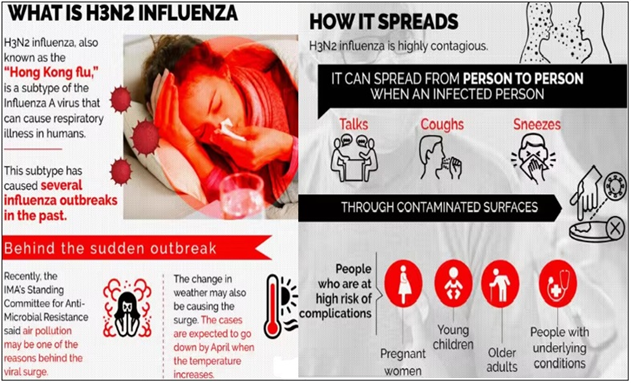Why in news?
- The Centre last week reviewed the rise in cases of influenza, and states have been readying hospitals for a possible spike in infections.
- The Union Health Ministry has confirmed a death each in Haryana and Karnataka due to the H3N2 subtype of the flu virus this month.
What’s in today’s article?
What is the H3N2 Virus?
- Influenza viruses, which cause the infectious disease known as flu, are of four different types: A, B, C and D.
- Influenza A is further classified into different subtypes and one of them is the H3N2.

Is H3N2 a new sub-type of influenza?
- No, it is one of the sub-types of the influenza virus that has been known to cause seasonal infections. In fact, H3N2 caused a flu pandemic back in 1968.
- In India, this sub-type was detected in 1996 and has since caused outbreaks too.
- The only difference this year is that the disease seems to be a little more severe.
News Summary: Flu cases rising in India
Why is there an increase in flu cases?
- Flu season
- Officials and experts said the current spike is because, first, this is the flu season as the season changes.
- India usually sees two flu peaks every year — between January and March and, post-monsoon, between August and October.
- Lower immunity
- Fewer flu infections during the pandemic has resulted in a large reservoir of people with lower immunity.
- The two pandemic years, 2020 and 2021, reported only 2,752 and 778 cases of the flu respectively.
- Every year there is a subclinical spread of influenza and people acquire some immunity to it.
- But during the pandemic, people masked up, stayed away from crowded areas, avoided gatherings, and this spread could not occur. Hence, there is an increase this year.
- Changing nature of flu virus
- The flu virus is prone to changing its structure. This means that we see an increase in flu cases usually every other year.
- Availability of flu shot
- India’s burden of conditions like diabetes and heart disease — which are risk factors for severe disease — is huge even among the young.
- The yearly flu shot is not readily available in government set-ups, and its uptake is not high.
Have Covid-19 cases spiked as well?
- At least two states, Gujarat and Maharashtra, have reported a new sub-variant of the novel coronavirus, XBB.1.16.
- However, very few genome sequences are available, and not much is known about the sub-variant yet.
- Researchers have said that although there seems to be a growth advantage — seeing as it is replacing previously dominant variants — whether it could lead to surge/severe cases is not known.
- Hospitals are still reporting Covid-19 cases with upper respiratory tract symptoms and fever, similar to what is seen with the flu.
- The Centre has written to six states — Tamil Nadu, Telangana, Kerala, Karnataka, Gujarat, and Maharashtra — asking them to carry out:
- adequate and proactive testing,
- monitor new and emerging clusters of infections,
- keep an eye on influenza like illnesses (ILI) coming to health facilities, and
- send samples of international travellers, sentinel sites, and clusters for genomic sequencing.
Is it unusual for people to die of the flu?
- Flu causes mild symptoms like fever, cough, and runny nose in most people.
- However, like Covid, it can lead to complications like pneumonia and Acute Respiratory Distress Syndrome (ARDS) that can lead to death.
- Very young children, old people, people with comorbidities such as heart disease, diabetes, and kidney disease, pregnant women, and those with a weakened immune system are at higher risk of getting severe disease.
Why is the flu shot updated every year?
- The flu vaccine usually contains four subtypes — two each of influenza A (H1N1 and H3N2 are recommended for 2022-23) and influenza B.
- The list of subtypes to be included in the yearly flu shot is updated by the World Health Organisation (WHO) twice a year depending on the types in circulation.
- The Indian Council of Medical Research (ICMR) network of viral laboratories, test respiratory samples throughout the year to continuously update the vaccine.
- This is because of the constantly evolving nature of influenza viruses.
- It can undergo an “antigenic drift” to acquire mutations that change the part that cause the body to elicit an immune response.
- It can also undergo an “antigenic shift” — an abrupt, major change that leads to a new protein structure of the virus.
- These shifts can lead to pandemics such as the one in 2009, or even the Spanish flu of 1918.










